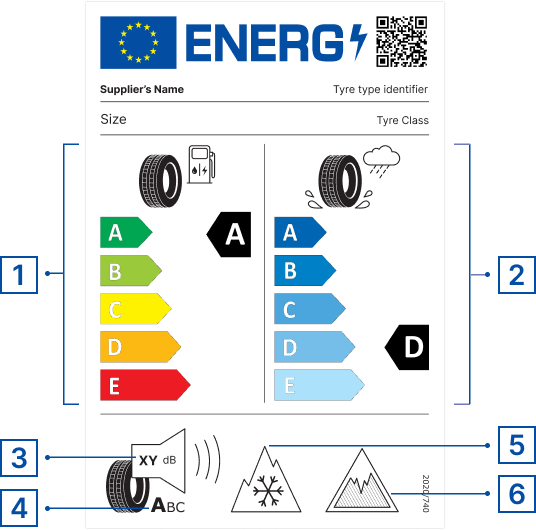Tyres are very sophisticated products where different performance parameters often conflict with each other and require complicated engineering developments as shortly illustrated hereafter: safety, efficiency and environmental performance parameters have to be duly balanced. They ensure comfort, acting as shock absorbers, and safety, by providing grip for braking, accelerating, maintaining steering and directional control in different weather and climatic conditions (on dry asphalt but also on wet surfaces or with heavy snow and severe ice conditions). Research and development in this market sector is hectic, aiming at complying with the stricter legislative requirements to improve their sustainability.
Scope
The following table shows some examples of products in scope and out of scope in the Energy Labelling Regulation:
| In Scope | Out of Scope |
|---|---|
|
|
Check the complete list in Article 2 of the Energy Labelling Regulation.
Tyres legislation
Tyres are covered by two sets of rules:
1. Minimal requirements tyres must satisfy to be placed on the Union market, are listed in Regulation (EU) 2019/2144 on type-approval for motor vehicles and their trailers, and systems, components and separate technical units intended for such vehicles.
2. Information requirements on tyres in the EU are set via the Tyre Labelling Regulation 2020/740, enabling users to make informed purchasing choices.
International UNECE test methods are used for assessing tyre performance in both sets of legislation.
Tyres are going to be covered by additional minimum requirements on emissions of microplastics (abrasion). Information requirements are going to cover the labeling of retreaded bus and truck tyres and classification according to abrasion and kilometers run (mileage).
Type-approval Legislation
The minimum requirements that a tyre has to satisfy to be placed on the European market are set in Regulation (EU) 2019/2144 which establishes additional type-approval requirements for the automotive sector.
This legislation is an endorsement, at EU level, of UNECE regulations: the same minimum requirements are in force in any country applying UNECE rules.
Increased restrictions on minimum performance levels for tyres have progressively outlawed tyres with the worst performance. This is why from 7 classes (for rolling resistance and wet grip) only 5 classes appear on the current label. Further restrictions apply from 2024 that will reduce the "populated classes" to only 4. Similarly, for noise only 2 of the 3 classes appearing in the label are really populated.
Tyre Labelling
Courtesy of Continental Reifen Deutschland GmbH
The label helps consumers make a more informed purchase decision when replacing their tyres.
Tyre labels need to provide a clear and common classification of tyre performance covering environmental aspects correctly balanced with safety ones, as different performance aspects are competing, thus tyre manufacturers aim to find the best compromise for performance in all parameters displayed on the label (and more).
Standardised tests are used to assess the performance of tyres in all the 5 parameters indicated in the label. National authorities perform random controls to verify the veracity of the performance levels claimed.
The European Product Registry for Energy Labelling (EPREL) offers more detailed information on all tyres placed on the EU market in the scope of the tyre Regulation (i.e. all tyres that have to be sold bearing a tyre label on them). This can be accessed by scanning the QR code featured on tyre labels. The comparison opportunity provided by EPREL drives manufacturers to innovate to have their tyres appearing in the top classes, excelling in energy efficiency, safety and emitted noise.
Vehicle manufacturers, as well, have to provide to potential vehicle customers the information on the tyres mounted on the vehicles they are interested in: the purchase offer has to include the label information for any tyre possibly mounted as first equipment (OEM).
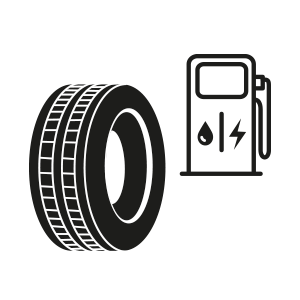 Rolling Resistance
Rolling ResistanceThe rolling resistance of a tyre is linked to the amount of energy used to move the vehicle it is fitted to: such resistance is related to a number of aspects, including:
- the tyre deformation (hysteresis) when a tire flexes as it meets the road surface; this is related to the tyre design (tread, bead, belt and sidewall). The elastic deformation converts the energy into heat;
- compounds used (e.g. silica, carbon-black, etc.), in the tread in particular.
- the inflation pressure (that modifies the hysteresis). Tyres properly inflated can have as much as a 10% energy savings impact.
- the load and distribution of the vehicle;
- road conditions;
- ambient, weather and tyre temperature.
The higher the rolling resistance, the less range your vehicles has with the same energy (or, conversely, the higher the fuel consumption for the same covered distance). Rolling resistance is a parameter with a relevant impact on economic aspects, on top of the environmental ones (such as CO2 emissions if the fuel is not from renewable origin). The difference between each class can mean on average a difference of 80 litres of fuel consumption in an internal combustion car during the tyre lifetime or tens of kilometres of range for each charge for a battery electric vehicle.
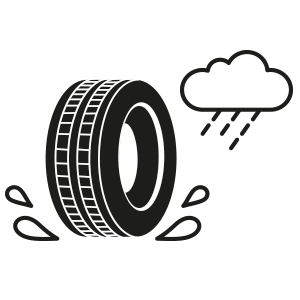 Wet Grip
Wet GripThe wet grip class is a critical safety feature, relating to the distance the vehicle takes on wet asphalt to stop when brakes are pushed hard. Tyres are rated A (the shortest braking distance) to E (the longest braking distance). In an emergency situation, a few metres can even save a life. The difference between a class and another can mean an extra 3-6 metres on the stopping distance. Wet grip decreases when the tread is worn and the risk of aquaplaning increases.
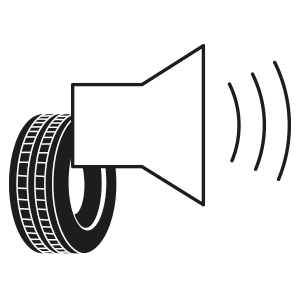 Rolling Noise
Rolling NoiseThe external rolling noise relates to the noise produced by the tyre and perceived by a person when a vehicle passes by. It is measured in dB(A) (A-weighted decibels). Noise classes range from A (less noise outside the vehicle) to B (more noise). Noise levels in the C class are only allowed for very specific tyres (because in restriction introduced by type approval legislation. By choosing a tyre with a good noise rating you lower the impact of your driving on the surrounding environment. A difference of 3dB doubles the amount of external noise the tyre produces. Tyres with a low noise level have between 67 and 71 dB, the highest levels are up to 77 dB.
This noise is different from the “cavity noise”, caused by resonance of the air inside the tyre cavity during rotation and that is propagated, via rims and organs, to the vehicle cabin (no rating exist for this noise).
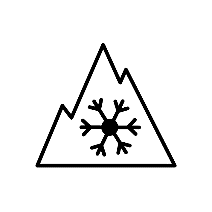 Snow Conditions
Snow ConditionsWinter tyres approved for use in severe snow conditions can be recognised by a specific pictogram, called the « Alpine symbol » or 3PMSF (3 Peaks Mountain with Snow Flake), that is also moulded on the tyre sidewall of such tyres. To bear the pictogram, the tyre has to pass a specific test, by measuring the braking distance of a car launched on compacted snow. For trucks, the pictogram is granted by measuring the acceleration performance of a tyre on such snow. Snow grip performance in general is tested in accordance with Annex 7 to UNECE Regulation No 117 that describes in detail factors as test surface, air temperature, testing vehicle, load, pressure, speed and more.
 Ice Conditions
Ice ConditionsNordic winter tyres, or ice tyres, approved for use in extremely cold conditions can be recognised by an additional specific pictogram, representing an ice stalagmite.These tyres provides a shorter braking distance on ice covered roads in winter and tests are according to the ISO standard 19447 (only C1 tyres, for passenger cars). These tyres are available in Nordic countries to be used only in those extremely cold winter conditions. Usually they have very poor performance on a wet surface, thus should not be used in southern countries. To bear the pictogram the tyre has to pass a specific test for braking on completely iced surface.
You may well compare the many tyres on the European market by consulting the products database EPREL

Consumers & Procurers
Legislation currently in force covers the following characteristics:
- Fuel/Energy efficiency: the indicator is the “rolling Resistance” of tyres (see hereafter);
- Wet grip: the indicator provides a proxy of the distance needed by a vehicle braking on wet asphalt;
- External rolling noise: this is the noise level perceived by a pedestrian when a vehicle passes-by;
- Suitability of use with snow and some ice: specific tests are foreseen, measuring the braking capabilities on heavy snow;
- Suitability of use with severe ice: specific tests are foreseen, measuring the braking capabilities on the sever ICE found in winter in artic regions;
- Wear(abrasion and mileage): these two parameters will be regulated in the near future.
Other parameters of possible relevance in consumer choice but not currently regulated at EU level include:
- Dry grip: the tyre's road adherence and braking capability on a dry asphalt. A slick tyre or a worn tyre have a generally good dry grip but are dangerous on wet asphalt;
- Handling: the way in which the vehicle/tire set responds to driver’s actions such as, such as steering, accelerating and braking;
- Chamber reverberation noise: the noise from asphalt reverberated to the rim and to the other mechanical parts (possibly perceived in the vehicle cabin) and not necessarily related to the external rolling noise.
The EU Taxonomy and tyres
The taxonomy is a classification system that defines criteria for economic activities that are aligned with a net zero trajectory by 2050 and the broader environmental goals other than climate. The EU taxonomy allows the sharing of a common definition of economic activities and products that can be considered environmentally sustainable.
The regulation brings clarity and transparency to the concept of environmentally sustainable economic activities, to foster sustainable finance and transition towards a greener economy.
The Taxonomy Technical Screening Criteria refers to tyres that must comply with external rolling noise requirements in the highest populated class and with Rolling Resistance Coefficient in the two highest populated classes as set out in Regulation (EU) 2020/740 and as can be verified from the European Product Registry for Energy Labelling (EPREL).
Rely on the EPREL database, which evaluates tire categories, sizes, performance in snowy conditions (3PMSF), load capacity, speed category, and ice performance (C1): EPREL provides a table that indicates, for each specific tyre size and selection criteria, how many are in each class (in tyre type units and share of total) and thus assess which are the highest "significantly populated" classes.
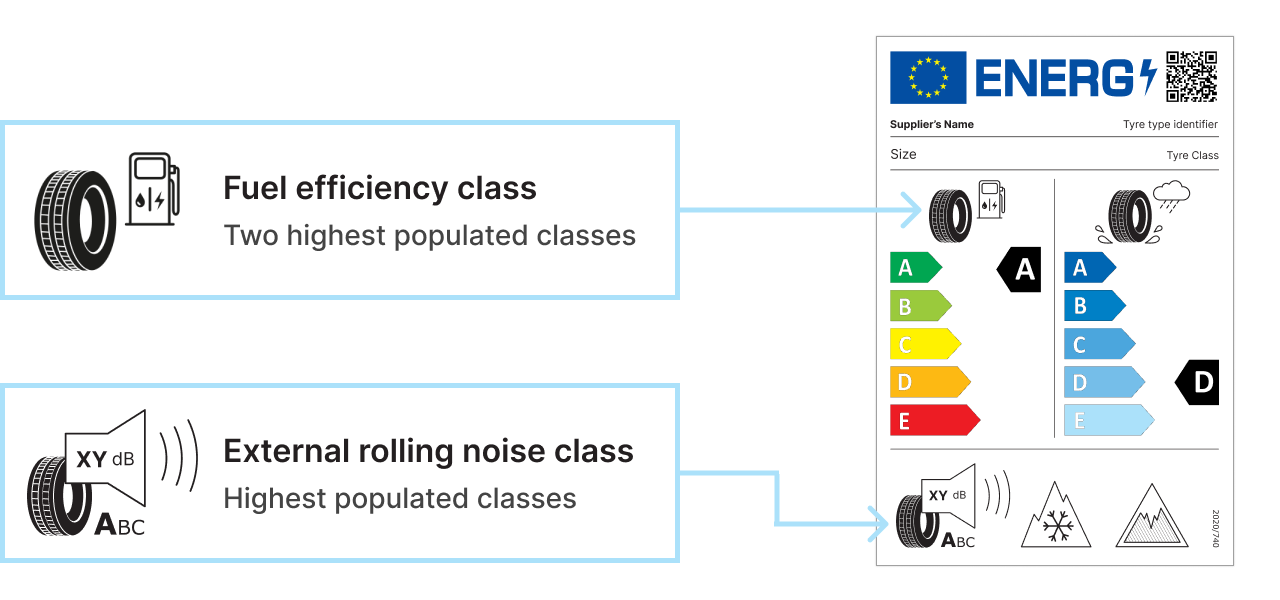
EPREL is your compass to determine whether or not your tires are ranked in the highest populated classes and thus align with the EU Taxonomy criteria.
Please note: The highest populated class is not automatically a label value “A”, because for a specific size and other selection criteria, the A class or even the B class may be empty (no tyre on the EU market). What counts is the highest class in that more than one tire is registered (= “populated“). "Significantly populated" refers to a sufficient number of different brands in the highest class (not to rely on a single brand, possibly not present in the specific country). A combined selection (i.e. on both rolling resistance and noise) is advisable to verify if the selection criteria provides a sufficient number of tyre types/brands in the highest classes.

EPREL as compass to determine class population
Eco-Tips and Tricks
- Regularly check your tyre pressure to ensure they are at the recommended level as pressure affects fuel consumption and vehicle handling.
- Check for signs of uneven wear in the tyres. This might indicate a tracking or camber problem that could increase fuel consumption, as well as wear your tyres out more quickly – costing you more money.
- Avoid harsh acceleration and decelerations. This increases your fuel consumption and wears out your tyres.
- Ensure the vehicle is maintained as per the manufacturer’s recommendations.
- Extra weight increases fuel consumption – regularly clear out any non-essential items from the vehicle.
Highlights
The tyre labelling Regulation, that first entered in force in 2012, has helped to reduce energy consumption by up to 45 TWh per year and to avoid roughly 15 million tonnes of CO2 emissions per year by 2020.
Facts & Figures
This graphic shows the estimated sales, stock, energy consumption (primary, electric or fuel), greenhouse gas emissions, consumer expenses and business revenues for years 2010 and 2030. The estimated values inside the graph bars are those from the EIA ECO-scenario.
The difference with the business as usual (BAU) scenario without these estimated measures is shown next to the graph bar. These figures indicate the estimated savings obtained due to the measures.
Product: Tyres Measures: Regulation (EU) 2020/740 ('Tyre Label') |
|---|
| The striped lines in the charts show the 'Effect of the Regulations' |
SALES (million units) 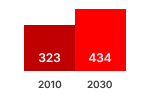 | STOCK (million units) 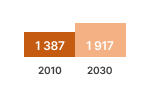 | Fuel (TWh/a) 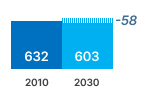 |
GHG-EMISSION 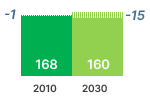 | CONSUMER EXPENSES 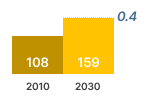 | REVENUES 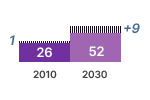 |
Source: estimations from the Ecodesign Impact Accounting Overview Report 2023
Expected Savings
The annual fuel consumption related to the rolling resistance of tyres was 650 TWh/a in 2005, before the introduction of tyre labelling measures. It is estimated this would have increased to 660 TWh/a by 2030 in the absence of the tyre labelling measures. The labelling regulation, including the 2020 revision, is projected to reduce this consumption to 603 TWh/a (-57 TWh, -9%).
These savings correspond to 15 Mt CO2eq/a lower GHG-emissions in 2030.
The EIA does not consider the indirect societal effects of the Tyre Labelling regulation, e.g. the decrease in health costs due to less victims and injuries from road incidents, due to better wet-grip of tyres, or the decrease in health costs due to lower emissions.
Total EU27 Fuel Losses due to RRC of Tyres
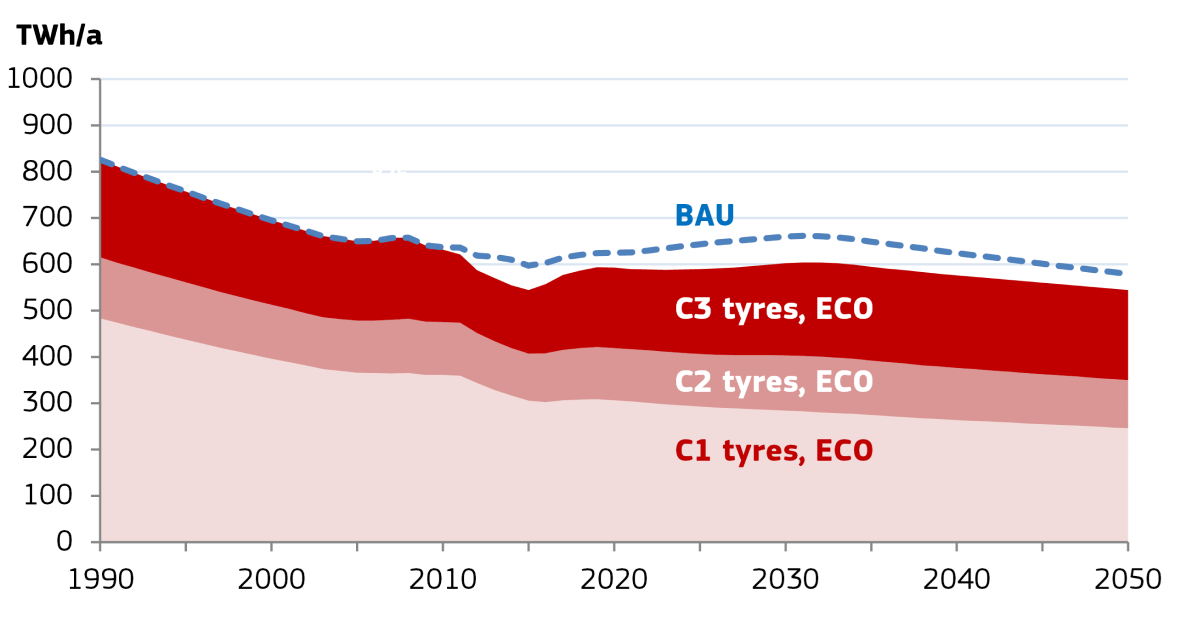
Source: estimations from the Ecodesign Impact Accounting Overview Report 2023

Suppliers
Tyre suppliers shall register in the product database EPREL any tyre type, in the scope of the tyre labelling Regulation, before they place it on the Union market. The steps necessary to perform such registrations are explained in the general section for suppliers.
The EPREL registration system automatically produces the tyre label with the required QR code on it. Tyre suppliers must ensure that any single tyre placed on the Union market has a sticker, with the label on it. Batches of identical tyres, sold to a single customer, may be accompanied by a single printed label.
The detailed and specific obligations on distributors and dealers are listed in Articles 4 and 5 of Regulation(EU) 2020/740.
You may find useful to consult the specific FAQs section on tyres for suppliers.

Tyre distributors and dealers
Tyre distributors shall ensure that at the point of sale, tyres are put in display with the label sticker well visible or, if the tyres are not visible, they must show anyhow the label before the purchase or any commitment is completed.
Specific obligations are set for promotional material, distance selling, telemarketing and on-line sales on the Internet. In short, the potential customer has always to have access to the label information and it must be placed close to the price indication or the "purchase" button, if any.
The detailed and specific obligations on distributors and dealers are listed in Article 6 of Regulation(EU) 2020/740.
You may find useful to consult the specific FAQs section on tyres for Distributors and Tyre Dealers

Vehicle suppliers
The label has to help the end-user in making an informed purchase choice.
Vehicle suppliers and vehicle distributors must provide to the potential customer, that "intend to acquire a vehicle", the information on the tyre label for all tyres offered with or fitted on the vehicle. “Intend to acquire” suggests that the purchase decision is close to be taken but not formalised yet, as, in principle, it may influence their purchase choice (e.g. on which rims-tyre combination)..
The obligation can be considered to be fulfilled if the information on the tyre label and in the relevant technical promotional material is part of the documentation provided to the end-user “intending to acquire” a new vehicle.
The obligation has to be fulfilled at the very latest before an irreversible action such the signature of the purchase contract.
This has to be considered as applicable not only for a vehicle displayed in a store, but also for on-line sales.
The specific obligations on vehicle manufacturers are listed in Article 7 of Regulation(EU) 2020/740.
You may find useful to consult the specific FAQs section on tyres for vehicle suppliers and distributors.
Documents
- 20 DECEMBER 2023
- 2 APRIL 2024
- 20 DECEMBER 2023
- 20 DECEMBER 2023

Policy
Ongoing legislative work
Please check the ongoing initiatives on the Have your say portal.
Regulation (EU) 2020/740 of the European Parliament and of the Council of 25 May 2020 on the labelling of tyres with respect to fuel efficiency and other parameters, amending Regulation (EU) 2017/1369 and repealing Regulation (EC) No 1222/2009 (Text with EEA relevance).
Regulation (EU) 2019/1020 of the European Parliament and of the Council of 20 June 2019 on market surveillance and compliance of products and amending Directive 2004/42/EC and Regulations (EC) No 765/2008 and (EU) No 305/2011 (OJ L 169, 25.6.2019, pp. 1-44)
Regulation (EU) 2018/858 of the European Parliament and of the Council of 30 May 2018 on the approval and market surveillance of motor vehicles and their trailers, and of systems, components and separate technical units intended for such vehicles, amending Regulations (EC) No 715/2007 and (EC) No 595/2009 and repealing Directive 2007/46/EC (OJ L 151, 14.6.2018, pp. 1-218)
Regulation (EU) 2017/1369 of the European Parliament and of the Council of 4 July 2017 setting a framework for Energy Labelling and repealing Directive 2010/30/EU (OJ L 198, 28.7.2017, pp. 1-23)
Regulation (EC) 1222/2009 of the European Parliament and of the Council of 25 November 2009 on the labelling of tyres with respect to fuel efficiency and other essential parameters (OJ L 342, 22.12.2009, pp. 46-58)
Regulation (EC) 661/2009 of the European Parliament and of the Council of 13 July 2009 concerning type-approval requirements for the general safety of motor vehicles, their trailers and systems, components and separate technical units intended therefor (OJ L 200, 31.7.2009, pp. 1-24)
Commission communication 2012/C 86/03 in the framework of the implementation of Commission Regulation (EU) No 1235/2011 amending Regulation (EC) No 1222/2009 of the European Parliament and of the Council with regard to the wet grip grading of tyres, the measurement of rolling resistance and the verification procedure Text with EEA relevance (Publication of the reference laboratories for the purpose of the alignment procedure concerning the measurement of rolling resistance of tyres for the implementation of Regulation (EC) No 1222/2009 as amended by Regulation (EU) No 1235/2011)
REPORT FROM THE COMMISSION TO THE EUROPEAN PARLIAMENT AND THE COUNCIL on the delegation of the power to adopt delegated acts conferred on the Commission pursuant to Regulation (EU) 2020/740 of the European Parliament and of the Council of 25 May 2020 on the labelling of tyres with respect to fuel efficiency and other parameters


